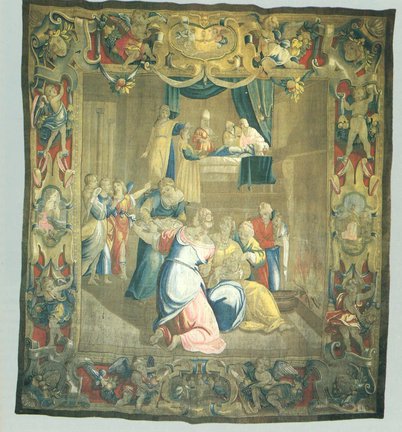Campata sinistra 1
La prima campata settentrionale è illuminata dal finestrone gotico della facciata, ma resta cieca sopra l’altare perché a ridosso dell’edificio del Broletto.
La vetrata dipinta dal milanese Pompeo Bertini (1854-55) rappresenta i santi Liberata e Faustina, Proto e Giacinto.
La pala d’altare fu dipinta nel 1502 da Andrea de Passeri, pittore di Torno : raffigura la Madonna col Bambino fra i santi Pietro (con il libro e le chiavi) e Tommaso (con la cintola affidatagli da Maria secondo la tradizione). Inginocchiati personaggi della famiglia committente, i Vitudono, il canonico Giacomo e una parente. Il dipinto, rinascimentale per l’impostazione prospettica, mantiene motivi di cultura gotica cortese come la gerarchia nelle dimensioni dei personaggi e il drappo retto dagli angeli. Di formato in origine rettangolare è stato adattato a una cornice in marmo del 1717.
Gli ex-voto d’argento attorno all’altare sono del XIX e XX secolo: esprimono gratitudine alla Madonna per le grazie ricevute.
Sopra l’altare l’arazzo della Natività della Vergine fu tessuto a Firenze tra il 1633 e l 1636 .
Il cartone di progetto è del pittore di Como Giovan Battista Recchi che si ispirò alla tela dipinta dal Morazzone per la Cappella della Cintura in S. Agostino in Como (1611-12).
Sulla parete della facciata, tra la porta e il tempietto del fonte battesimale, c’è la custodia degli oli santi . È di marmo bianco di Musso, scolpito con fregio di tralci di vite e uccellini che beccano acini d’uva dall’evidente significato eucaristico. In origine era dipinto e dorato: si tratta del tabernacolo del sec. XV
Questa cappella, immediatamente accessibile per i fedeli dalla piazza, è stata per secoli uno spazio di devozione popolare alla Madonna, prima colla pala del Luini (detta nell’800 “Madonna dell’aiuto”) poi con quella del De Passeri, qui trasferita nel tardo ‘600.
Come le altre campate laterali era considerata a tutti gli effetti una cappella, dedicata a San Gerolamo, padre della Chiesa, raffigurato a mezzo rilievo dipinto nella chiave della volta a crociera soprastante la campata . Della cappella era titolare la famiglia Raimondi e da qui proviene la pala di Bernardino Luini ora nella quinta campata meridionale.
L’arazzo della Natività della Vergine, rimasto per decenni arrotolato nel magazzino sopra la Sacrestia dei Mansionari è stato ricollocato qui nel maggio 2016. È il più grande arazzo del Duomo (cm 468 x 426), l’ultimo realizzato (1633/1636) ed è l’unico più alto che largo e pure l’unico modellato su cartone di un artista comasco Giovan Battista Recchi (tela a olio, Digione Museo Magnin). Tessuto in lana e seta a Firenze dall’arazziere Scipioni Ammirati, l’arazzo giunse a Como nel 1636. Fu pagato 1461 lire dalla Compagnia del Santissimo Sacramento. La bordura dell’arazzo, progettata dal Recchi, dispone attorno angioletti con festoni vegetali e medaglioni con l’Annunciazione, l’Assunzione e la Scala di Giacobbe, emblema mariano. Esposto nella Mostra Voltiana di Como nel 1899, l’arazzo fu poi appeso qui.
La vetrata di S. Liberata fu ridisegnata “in grandezza naturale” e rifatta dalla ditta Corvaia e Bazzi di Milano dopo i danni di un uragano (1922-1923).



